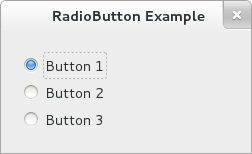
These radiobuttons report their activity in the terminal.
1 2 3 4 5 6 7 8 9 10 11 12 13 14 15 16 17 18 19 20 21 22 23 24 25 26 27 28 29 30 31 32 33 34 35 36 37 38 39 40 41 42 43 44 45 46 47 48 49 50 51 52 53 54 55 56 57 58 59 60 61 62 63 64 65 66 67 68 69 70 71 72 73 74 75 76 77 78 79 80 81 82 83 84 85 86 87 88 89 90 91 92 93 94 95 96 97
#include <gtk/gtk.h>
/*Signal handler for the "toggled" signal of the RadioButton*/
static void
button_toggled_cb (GtkWidget *button,
gpointer user_data)
{
char *b_state;
const char *button_label;
if (gtk_toggle_button_get_active (GTK_TOGGLE_BUTTON (button)))
b_state = "on";
else {
b_state = "off";
g_print ("\n");
}
button_label = gtk_button_get_label (GTK_BUTTON (button));
g_print ("%s was turned %s\n", button_label, b_state);
}
static void
activate (GtkApplication *app,
gpointer user_data)
{
GtkWidget *grid;
GtkWidget *window;
GtkWidget *button1;
GtkWidget *button2;
GtkWidget *button3;
/*Create a window with a set title and default size.
Also, set a border width for the amount of space to leave
inside the window*/
window = gtk_application_window_new (app);
gtk_window_set_title (GTK_WINDOW (window), "RadioButton Example");
gtk_window_set_default_size (GTK_WINDOW (window), 250, 100);
gtk_container_set_border_width (GTK_CONTAINER(window), 20);
/*Create an initial radio button*/
button1 = gtk_radio_button_new_with_label (NULL, "Button 1");
/*Create a second radio button, and add it to the same group as Button 1*/
button2 = gtk_radio_button_new_with_label_from_widget (GTK_RADIO_BUTTON (button1),
"Button 2");
/*Create a third button, and add it to the same group as Button 1*/
button3 = gtk_radio_button_new_with_label_from_widget (GTK_RADIO_BUTTON (button1),
"Button 3");
/*Create a grid, attach the buttons, and position them accordingly*/
grid = gtk_grid_new ();
gtk_grid_attach (GTK_GRID (grid), button1, 0, 0, 1, 1);
gtk_grid_attach (GTK_GRID (grid), button2, 0, 1, 1, 1);
gtk_grid_attach (GTK_GRID (grid), button3, 0, 2, 1, 1);
/*Be sure to set the initial state of each button*/
gtk_toggle_button_set_active (GTK_TOGGLE_BUTTON (button2), TRUE);
gtk_toggle_button_set_active (GTK_TOGGLE_BUTTON (button1), FALSE);
gtk_toggle_button_set_active (GTK_TOGGLE_BUTTON (button3), FALSE);
/*Connect the signal handlers (aka Callback functions) to the buttons*/
g_signal_connect (GTK_TOGGLE_BUTTON (button1), "toggled",
G_CALLBACK (button_toggled_cb), window);
g_signal_connect (GTK_TOGGLE_BUTTON (button2), "toggled",
G_CALLBACK (button_toggled_cb), window);
g_signal_connect (GTK_TOGGLE_BUTTON (button3), "toggled",
G_CALLBACK (button_toggled_cb), window);
gtk_container_add (GTK_CONTAINER (window), GTK_WIDGET (grid));
gtk_widget_show_all (window);
}
int
main (int argc, char **argv)
{
GtkApplication *app;
int status;
app = gtk_application_new ("org.gtk.example", G_APPLICATION_FLAGS_NONE);
g_signal_connect (app, "activate", G_CALLBACK (activate), NULL);
status = g_application_run (G_APPLICATION (app), argc, argv);
g_object_unref (app);
return status;
}
In this sample we used the following:
Got a comment? Spotted an error? Found the instructions unclear? Send feedback about this page.